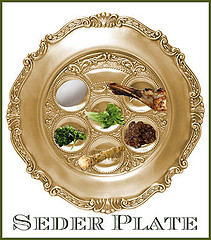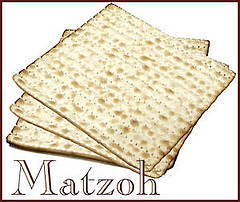 Springtime marks a time of renewal on so many levels for individuals throughout the world.
Springtime marks a time of renewal on so many levels for individuals throughout the world.
People look forward to celebrating it in many ways. In Part 1 of 2 we mentioned a bit about Celebrating Easter in Springtime. In this Part 2 of 2 we will focus on those who choose to commemorate Purim through Passover.
(Passover lens graphic courtesy of Resabi over at Squidoo.com)
Disclaimer: Please consult your local Rabbinical Authority to determine whether any items you chose qualify as being specifically certified “Kosher for Passover” (Kosher L’Pesach certification) vs. use at other times as being certified “Kosher” (aka Kashrut, Kashrus or Kashruth) per se. Your local Rabbinical Authority is the best source of information on Pesach and can suggest version choices of the Haggadah which in turn will influence your Passover Seder celebration and following meal planning accordingly.
There are a wide variety of tips that can enable almost anyone to enjoy healthier version options of favorite food items prepared and served as part of any Passover Commemoration should you decide you want to explore updating them.
Some of these tips might be applicable and appeal, depending upon whether or not you need to consider any other special diet restrictions for medical or other reasons.
As always, please check with your medical professional when it comes to matters pertaining to your individual health or that of your family members.
Besides the tips below and elsewhere on the www, there are also various cookbook options with recipes by others, etc., for purchase, should you wish to pursue adding any new paper cookbooks to your physical book library. (One such physical paper book option would be EnLITEned Kosher Cooking from the Jewish Diabetes Association available through their website with more than 140 recipes for Pesach along with what they consider to be easily adaptable year-round recipe choices emphasizing vegetables and vegetable combinations per their website). You can see a full list of their recipes on their website.
That site has a good approach for anyone living with a condition such as diabetes to keep in mind when dealing with any holiday “Remember that failing to prepare is preparing to fail!”
When it comes to food choices, any decision is always yours to make.
Some individuals without a specific medical condition may be able to and choose to allow themselves a little indulgence one day and make up for it on some other days.
We fully respect your right to follow the approach that works for you!
As we do not come from a Jewish heritage, suggestions for Passover noted below have come from other sources where individuals claim familiarity with Jewish traditions. Any omissions or errors are totally unintentional and will gladly be corrected if we are alerted to any such concerns and provided with links to alternate substantiated details. Remember that we only offer infotainment through this blog site as noted in our disclaimers.
For those who celebrate Passover (one of the three Pilgrimage Festivals in Jewish tradition), the Purim that precedes it creates a fabulous opportunity for Spring cleaning of pantry and refrigerator storage and actually sets an example other cultures could learn from to clean out those areas thoroughly in Spring time (as well as other times of the year, too!)
Persons of Jewish heritage who commemorate the Passover holiday must ahead of time honor Purim (start date in 2012 was March 7-8th*) and remove anything that is “chametz” aka “chometz” meaning of leavened grain so that means any liquid or solid made from any modern day equivalent grain to those of yesteryear that was fermented or leavened cannot be kept anywhere in the house–no fermented or leavened products from barley, rye, oats, spelt, or wheat can be consumed during the eight days of Passover. (Wikipedia states that “Chametz is a product that is both made from one of five types of grain, and has been combined with water and left to stand raw for longer than eighteen minutes.” Please see that site for further details. Per the Jewish Diabetes Association, that means all chametz must be gone from a household by Friday morning, April 6th, 2012.
In these more modern times, it is reported that these “chametz” items can be “sold” to a non-Jew friend for safe keeping or else donated; if “sold” to a non-Jew friend, they can be bought back again after the holiday is all over. Work on ridding the household of anything “chametz” can easily take several weeks to a month commencing with the Purim start date prior to Passover.
 Dietitians of Jewish heritage have at times lamented that the majority of “traditional” family recipes for the dinner celebration at the end of the evening of the Passover Seder (held the first two of the eight nights of the Passover commemoration), especially those brought to the United States from Eastern Europe, happen to use a lot of three ingredients that those with concerns for diabetes and heart disease might want to seriously re-think: whole eggs; high use of schmaltz aka rendered chicken fat, along with stick margarine or less healthy oil choices; and sugar and could accordingly benefit from some updating.
Dietitians of Jewish heritage have at times lamented that the majority of “traditional” family recipes for the dinner celebration at the end of the evening of the Passover Seder (held the first two of the eight nights of the Passover commemoration), especially those brought to the United States from Eastern Europe, happen to use a lot of three ingredients that those with concerns for diabetes and heart disease might want to seriously re-think: whole eggs; high use of schmaltz aka rendered chicken fat, along with stick margarine or less healthy oil choices; and sugar and could accordingly benefit from some updating.
(Passover Seder plate graphic courtesy of Resabi over at Squidoo.com)
Actually, some of these same concerns can be echoed for recipes celebrating Easter that were brought to the United States by families who immigrated here from Europe as well!
Beyond trimming any excess visible fat, cutting back on pareve margarine and avoiding vegetable-shortening, limiting use of schmaltz aka rendered chicken fat, and avoiding frying when possible, there are several other ways to adapt recipes for Passover and some will even increase the Omega-3 or Omega-9 fatty acid value of the Passover meal by making several simple changes:
–Enjoying servings of Charoset aka Haroset: there are many, many traditional recipes for Passover Charoset/Haroset, which can often include heart-healthier walnut meats that are also rich in Omega-3 fatty acids, along with naturally sweet fruits including apples, dates, figs, raisins, etc. (Toasting leftover nuts such as almonds, walnuts, and hazelnuts to bring out their flavor and storing them in the freezer for best keeping quality for future use can be a wise practice). Many recipe versions of this dish can be found on the www from literally all over the world. A version of these tiny balls as truffles has even been served at the White House!
–Consuming legume/bean options (including, but not limited to, adzuki beans, chickpeas, kidney beans, French lentils), as well as fresh fruits, and lots of vegetables can also boost fiber intake during Passover.
–Noting that Kosher for Passover Confectioner’s Sugar will be a potato starch & sugar mixture (rather than cornstarch and sugar) in keeping with using potato starch rather than corn starch during Passover.
–Speaking of using Potato Starch instead of Corn Starch for Passover, why not also consider serving baked versions of either white or sweet potatoes with their jackets on for any holiday meal?
–Wild salmon (rich in heart-healthier Omega-3 fatty acids) can be a wonderful entree alternative to chicken and you can add a little bite to the entree by serving traditional horseradish (bitter herbs of the Seder) with it, or going perhaps with a cranberry walnut topping or another topping instead.
— When it comes to using whole grains, there is even some “Kosher for Passover” quinoa grain (limited verified sourcing) in some stores that can be an alternative grain choice. Some other grain options to consider might include Kasha (buckwheat), millet, wild rice, and brown rice.
 –When it comes to matzos aka matzoh choices, looking for higher-fiber options as both unleavened bread and matzos meal.
–When it comes to matzos aka matzoh choices, looking for higher-fiber options as both unleavened bread and matzos meal.
Making a vegetable matzos lasagna, vegetable based soups, and steaming veggies are other ways to lighten up meals. Matzos versions for Passover are sold now reflecting a wide use of grains as noted on their labels, including both gluten-containing (rye, spelt, whole wheat) and gluten-free options. Ground nuts can substitute for matzos crumbs/meal in some recipes (those on gluten-free diets have used that substitution for years).
(Matzoh graphic courtesy of Resabi over at Squidoo.com)
–Lowering fat content in matzos balls for Passover chicken soup by simply using egg whites to replace some whole eggs and replace the schmaltz (aka rendered chicken fat) with heart healthier, Omega-9 rich olive oil, which has the potential to increase levels of healthy fatty acids in the body.
–Substituting Canola or Sunflower oil in those Passover baking recipes traditionally made with Cottonseed Oil (which has more saturated fatty acid content); substituting Walnut Oil in fish, poultry, or salad dishes that call for Hazelnut Oil; and using a Kosher for Passover Cooking Spray for pans and dishes to make it easier for both sautéing and also for baked goods to be removed from pans thus speeding kitchen cleanup.
–Although we do suggest using less fat where possible in many recipes, don’t try using whipped, unsalted Passover margarine as the fat content will be too low to produce the baking results you would hope for. As a rule of thumb, don’t go below 68% fat content when preparing sugar type cookies or most crumb crusts; and don’t go below 52% fat content when preparing other baked goods products.
–Preparing baked goods for Passover substituting 1/4 cup of natural, unsweetened applesauce for 1 whole egg in traditional recipes (or use one of the other applicable fat substitutions mentioned in previous blog posts).
–Making Passover macaroons with egg whites and unsweetened Passover cocoa powder or using a higher Omega-3 content whole egg if you keep one in the recipe.
–Using medium granulation matzos meal & matzos cake meal will contribute to keeping any Passover cake moister than using either fine or coarse matzos meal would according to Jewish bakers we spoke with.
–Using Passover Baking Powder rather than Passover Baking Soda for any recipes that might involve non-alkali processed cocoa powder; or semi-sweet, bittersweet or unsweetened chocolate chips or bars.
–Modifying Passover baked goods recipes to have perhaps closer to 66% (aka 2/3) of the original sugar content (such as cutting back in the sugar level of any filling, etc.) as unless the sugar is involved in the structural integrity of the recipe, that modification will most likely work out just fine.
–Enjoy using Passover approved extracts from Passover Vanilla Extract to those of almond, orange, lemon or mint origin to boost the flavor in recipes.
We couldn’t agree more with Cheryl Forberg, RD, a Registered Dietitian and James Beard award-winning chef who has been the nutritionist for The Biggest Loser over twelve seasons spanning seven years, who has authentic expertise when it comes to Jewish traditions, to put “Flavor First” and that includes for holidays and every day! Cheryl has been planning for her new Farmhouse Kitchen for some time and it will enable her to have a wonderful stage for many celebrations to come.
Purim and Passover are commemorated in the home setting and for all those involved in the activities, we hope they will be very meaningful and memorable for you this year.
![]()
*Note: The Jewish calendar date begins at sundown of the night beforehand. Thus holiday observances begin at sunset of the first secular date listed (with the Purim Night Megillah reading taking place that evening), and the holiday concludes at nightfall the following day.

